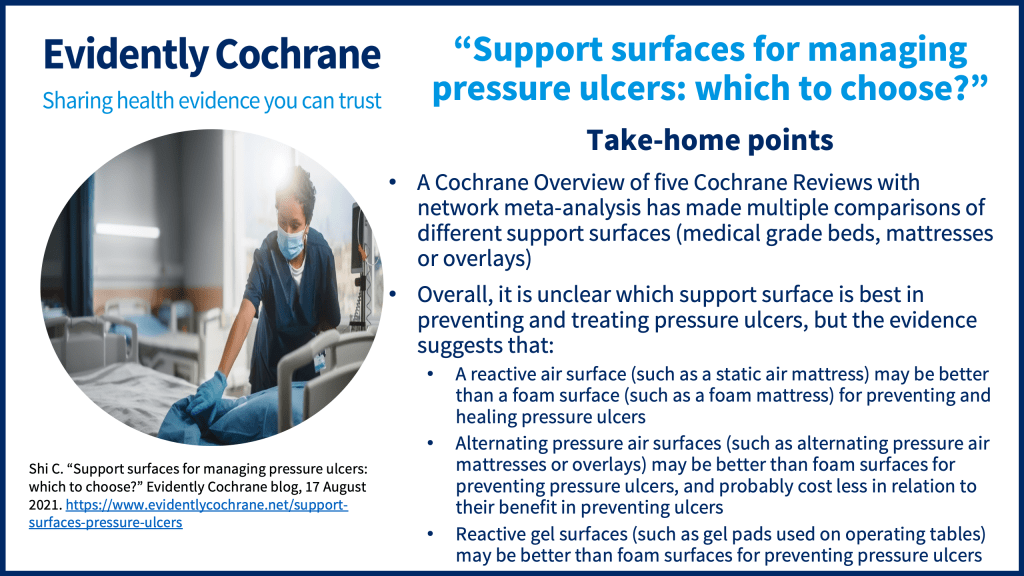In this blog for nurses, Chunhu Shi, a nurse and lead author of a Cochrane Overview, shares what the latest evidence tells us about support surfaces for managing pressure ulcers, and what we still don’t know.
Page last checked 11 July 2023
Take-home points

This evidence comes from the Cochrane Overview: Beds, overlays and mattresses for preventing and treating pressure ulcers: an overview of Cochrane Reviews and network meta-analysis.
So many choices of support surfaces…
Support surfaces such as medical grade beds, mattresses or overlays are widely-used in patient care to relieve pressure on the body with the aim of preventing and treating pressure ulcers. There are many types from which to choose. They can be made of a range of materials (such as foam, air cells, gel, medical sheepskin, fibre and water-filled bags). Whatever the materials used, a support surface belongs to one of two general categories:
- reactive (static) surfaces, which apply a constant pressure to the skin, unless a person moves or is repositioned; or
- alternating pressure (active) surfaces, which regularly redistribute the pressure under the body.
Current recommendations and practice for preventing and treating pressure ulcers
The 2014 NICE clinical guidelineA systematically developed statement for practitioners and participants about appropriate health care for specific clinical circumstances. in the UK Pressure ulcers: prevention and management, has recommended using foam mattresses for preventing pressure ulcers in adults at riskA way of expressing the chance of an event taking place, expressed as the number of events divided by the total number of observations or people. It can be stated as ‘the chance of falling were one in four’ (1/4 = 25%). This measure is good no matter the incidence of events i.e. common or infrequent. of having a pressure ulcer, and for treating pressure ulcers.
However, other types of support surfaces such as reactive air mattresses or overlays, and alternating pressure air mattresses or overlays, are also commonly used.
The NICE guideline does not contain evidence on how support surfaces compare, or evidence on which support surface is the most effective. This leaves decision-makers with a confusing array of devices to choose from but evidence uncertainty.
A “one-stop-shop” of evidence on support surfaces
In order to deal with this confusing array of evidence about support surfaces, we created a “one-stop-shop”, called a Cochrane Overview of ReviewsCochrane Overviews of reviews (Overviews) are intended to summarize multiple Cochrane Reviews addressing the effects of two or more potential interventions (for example a drug, surgery, or exercise) for a single condition or health problem.. We summarised evidence from five Cochrane ReviewsCochrane Reviews are systematic reviews. In systematic reviews we search for and summarize studies that answer a specific research question (e.g. is paracetamol effective and safe for treating back pain?). The studies are identified, assessed, and summarized by using a systematic and predefined approach. They inform recommendations for healthcare and research. on support surfaces for preventing and treating pressure ulcers:
- Alternating pressure (active) air surfaces for preventing pressure ulcers
- Foam surfaces for preventing pressure ulcers
- Reactive air surfaces for preventing pressure ulcers
- Alternative reactive support surfaces (non-foam and non-air-filled) for preventing pressure ulcers
- Beds, overlays and mattresses for treating pressure ulcers
The Cochrane Overview also contains an advanced analysis called ‘network meta-analysis’ in which we combined all the available dataData is the information collected through research. from randomisedRandomization is the process of randomly dividing into groups the people taking part in a trial. One group (the intervention group) will be given the intervention being tested (for example a drug, surgery, or exercise) and compared with a group which does not receive the intervention (the control group). controlled trialsA trial in which a group (the ‘intervention group’) is given a intervention being tested (for example a drug, surgery, or exercise) is compared with a group which does not receive the intervention (the ‘control group’). we had found. The analysis allowed us to compare the effects of all available support surfaces with each other to find out if any type of surface appears to be more effective.
We analysed data about the effects of support surfaces on pressure ulcer prevention and treatmentSomething done with the aim of improving health or relieving suffering. For example, medicines, surgery, psychological and physical therapies, diet and exercise changes. separately.
Preventing pressure ulcers
We found 68 randomised controlled trialsClinical trials are research studies involving people who use healthcare services. They often compare a new or different treatment with the best treatment currently available. This is to test whether the new or different treatment is safe, effective and any better than what is currently used. No matter how promising a new treatment may appear during tests in a laboratory, it must go through clinical trials before its benefits and risks can really be known. in the topic of preventing pressure ulcers, and linked 40 prevention studies (with 12,517 participants) to form a network joining 13 types of support surface.
All the studies we found involved people aged over 35 years, in a range of care settings including hospital wards, intensive care units, operating theatres, and nursing homes. These results are most likely to be relevant to similar populations.
Treating pressure ulcers
We found 12 randomised controlled trials in the topic of treating pressure ulcers, and linked 4 treatment studies (with 397 people) to form a network joining 4 types of support surface.
The data we found came from studies of people aged over 64 years, with ulcers over 16cm2 in size, in hospital and nursing home settings. These results are most likely to be relevant to similar populations.
We got results for 78 comparisons covering every pair of treatments in the first network in terms of prevention and 6 comparisons in the second network for treatment. We were also able to rank the treatments in order of effectivenessThe ability of an intervention (for example a drug, surgery, or exercise) to produce a desired effect, such as reduce symptoms.. We created an interactive tool to help people navigate all data.
What does the Cochrane Overview tell us that we didn’t know before?
Overall, we concluded that it is unclear which support surface is best in preventing and treating pressure ulcers.
Unfortunately, we can’t trust most of the results from the two networks. This is mainly because many of the original trials were poorly conducted, small, and trial data in the network could not produce precise results.
However we found some new evidence:
- A reactive air surface (also known as static air mattress) may be better than a foam surface or overlay for preventing and healing pressure ulcers. Foam mattresses are recommended in the 2014 NICE clinical guideline and are routinely used in practice.
- Alternating pressure air surfaces may be better than foam surfaces for preventing pressure ulcers. Alternating pressure air surfaces probably cost less, overall, than foam surfaces in relation to their benefit in preventing ulcers.
- Reactive gel surfaces may be better than foam surfaces for preventing pressure ulcers. This type of surface is particularly relevant for people undergoing surgery that lasts several hours.
What next?
Thanks to some trials completed in recent years, the evidence base on using support surfaces to prevent and treat pressure ulcers has gradually changed. These trials include the PRESSURE trial, comparing two types of alternating pressure air surfaces, and the PRESSURE 2 trial, comparing foam surfaces with alternating pressure air surfaces, both funded by the NIHR. They have contributed some important UK data to this Overview. However, this topic still has some unanswered questions and keeps developing. Some ongoing trials might help us tackle some uncertainties.
Given the evidence that reactive air surfaces and alternating pressure air surfaces may have advantages over foam surfaces, should the 2014 NICE guideline recommendation of using foam surfaces be changed? At this moment, we could not say so without knowing if, compared with foam surfaces, people can gain more health benefits from reactive air surfaces and alternating pressure air surfaces without it costing more.
We do know however that reactive air surface and alternating pressure air surfaces are currently used in practice in the UK. They are perhaps as popular as foam surfaces in the UK particularly in specific care settings such as intensive care units. Besides, like foam surfaces, they are both recommended in the 2019 international guideline – though not the 2014 NICE guideline – for pressure ulcer management.
It is therefore important for nurses to know about the new evidence for making informed decisions about the different support surface options. We finally hope you would agree with us that, apart from the evidence, other factors would play important roles in decision-making. For example, the availability of advanced support surfaces, ease of use, cost, patient preference, and so on.
Chunhu Shi has nothing to disclose.
Read more ‘Evidence for Nursing’ blogs, including more about pressure ulcers
Join in the conversation on Twitter with @chunhu_shi, @CochraneUK and @CochraneWounds or leave a comment on the blog.
Please note, we cannot give medical advice and do not publish comments that link to individual pages requesting donations or to commercial sites, or appear to endorse commercial products. We welcome diverse views and encourage discussion but we ask that comments are respectful and reserve the right to not publish any we consider offensive. Cochrane UK does not fact check – or endorse – readers’ comments, including any treatments mentioned.


